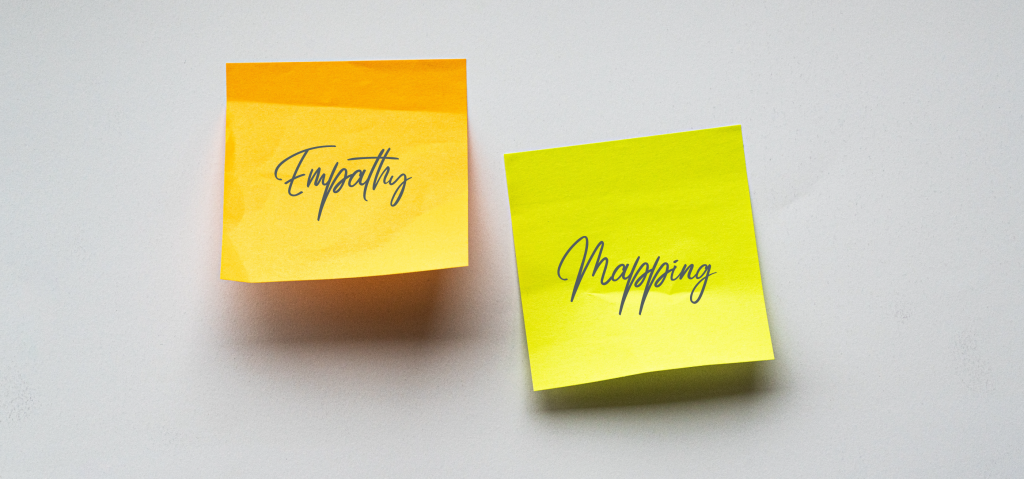
We have all heard the idiom that references walking a mile in someone else’s shoes. In Harper Lee’s To Kill a Mockingbird, the first lesson that Scout learns from Atticus is to put yourself in the place of other people. “You never really understand a person until you consider things from his point of view…until you climb in his skin and walk around in it,” Atticus says. Whichever way it has been phrased to you, you likely identify “stepping into someone else’s shoes” with empathy.

What is Empathy?
Empathy is the ability to understand and share another person’s thoughts, feelings, and experiences. This is most achievable when we set aside our assumptions, labels, judgments, and preconceived notions. Empathy allows us to feel each other’s pain, gain perspective, and acquire true understanding and appreciation of one another. To remain sensitive, civil, respectful, considerate, and humane, humans must remain empathetic.
Empathy is the most important human skill in the digital age.
– Katri Saarikivi, TEDxYouth@Kolmikulma
Empathy in UX
In user experience design, the first stage of the Design Thinking process is “Empathize.” This stage is all about engaging the world of your user, learning about them and their experiences, and finding out their needs and challenges. Empathizing with your user can come about through multiple practices, including conducting interviews, taking surveys, performing user testing, and more. As a UX professional, empathy mapping is an additional activity you can use to engage and advocate for your end-users.
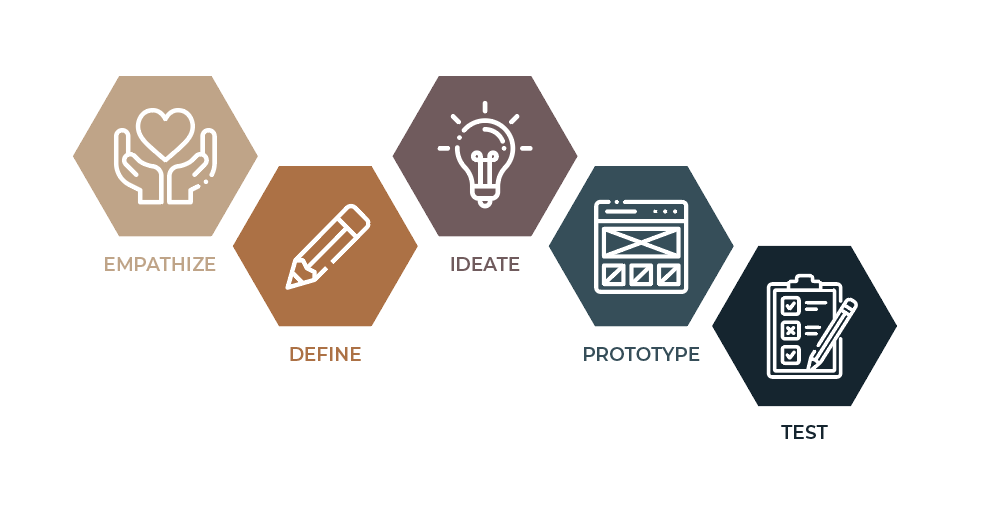
Empathy Mapping Explained
So, what is empathy mapping? In his Career Foundry article, Camren Browne explains that “Empathy maps are an efficient tool used by designers to not only understand user behavior but also visually communicate those findings to colleagues, uniting the team under one shared understanding of the user.” The empathy map, created by Dave Gray, is a way to gain emotional intelligence and insight from target groups like customers and users. Gray explains, “This particular tool helps teams develop deep, shared understanding and empathy for other people. People use it to help them improve customer experience, to navigate organizational politics, to design better work environments, and a host of other things.”
How to Empathy Map
Pictured below, an empathy map is a chart split into four quadrants with the user at the center. The quadrants can often overlap, and a user’s response may fall into multiple spaces, but the key is to pick one. Additionally, if a user’s responses resemble one another, they can be grouped and categorized.
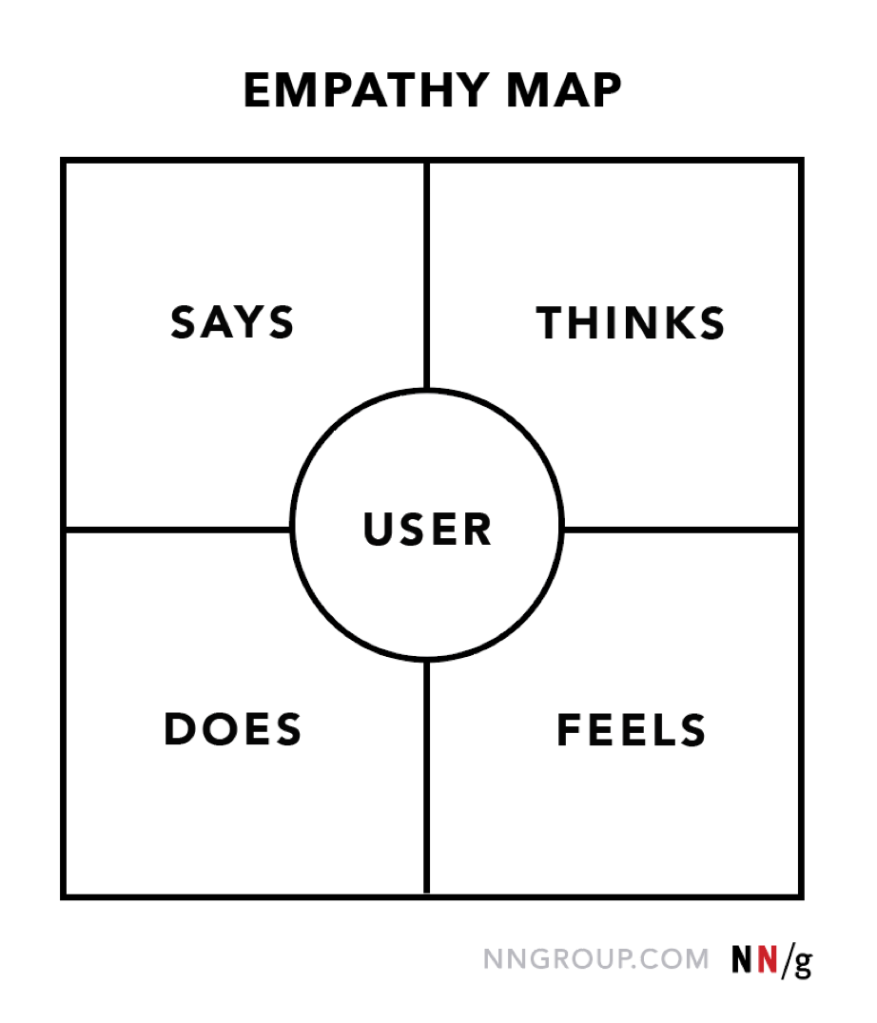
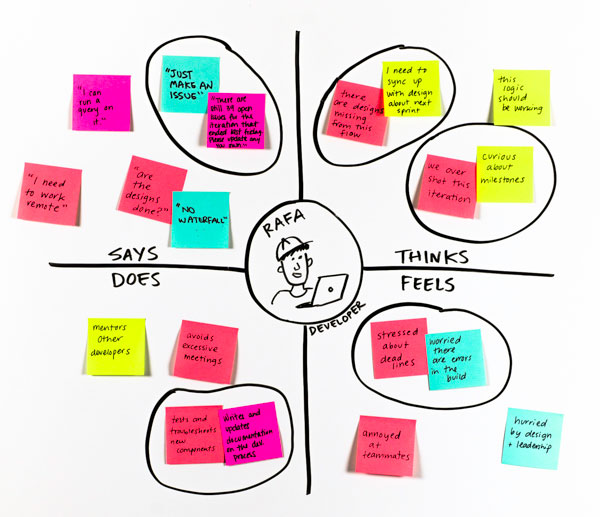
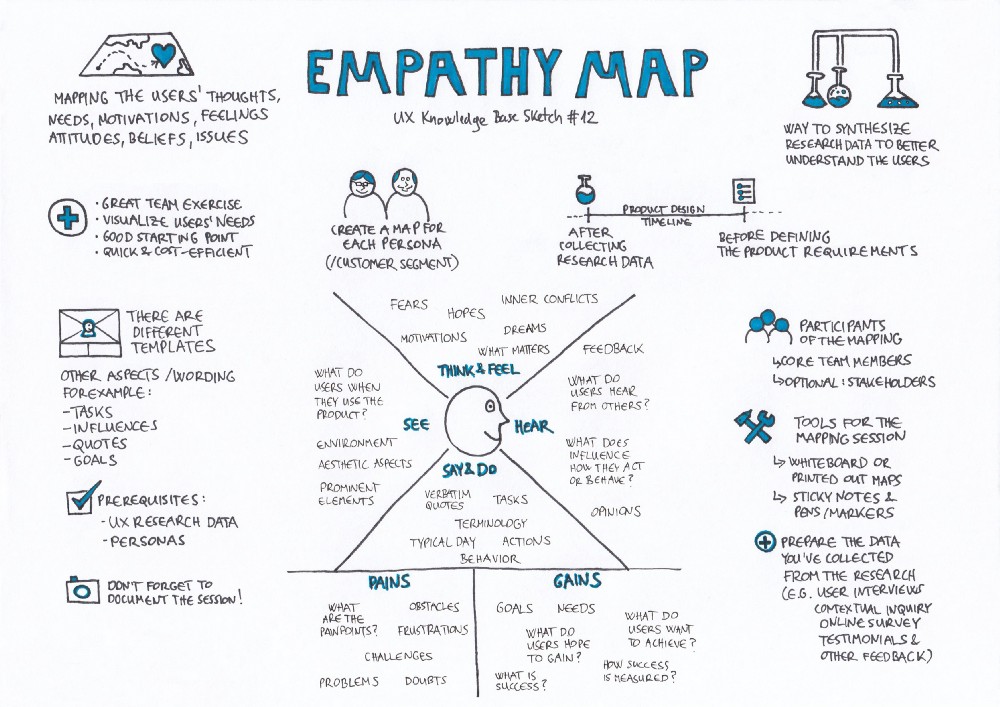
Empathy Map Examples: Nielsen Norman Group, IBM, UX Knowledge Base Sketch
Here’s how you use each quadrant:
- The “Says” quadrant is where you write down what the user says out loud about the product/service. This quadrant contains direct quotes.
- The second quadrant is called the “Thinks” quadrant. Unlike the recordings from quadrant 1, what the user thinks is implicit. Here, you gather what the user thinks, but does not say. You can derive these things through the observation of your user.
- Next is the “Does” quadrant. This is a space to record your user’s actions. You should take note of the way the user interacts with the product/service.
- The final space, “Feels,” contains the user’s emotional state. These items can be implicit as well, so observation is necessary.
If you end up with an empty quadrant at the end of the exercise, that’s a clear sign to double back, do more research, and gain more insight.
Why Empathy Mapping is Important
In UX, empathy mapping is a great strategy to understand a user’s experiences, needs, and goals in a unique and organized way. According to IBM, “it’s important to remember that you are not your users.” Observing what a user says, thinks, does, and feels highlights possible challenges the user may be experiencing first-hand. This helps UX professionals find solutions to these challenges.
Furthermore, empathy maps help UX professionals capture who a user is. It is an innovative way to perform research on the people or type of person who use(s) a product/service. Once you have gained a deeper understanding of your user and their needs, you can relay the information you learned to others effectively. The more understanding you and your team have, the more capable you are to meet your user’s needs. Moving forward, this helps shape your objectives and deter bias.
Final Thoughts
User experience focuses on understanding how a user interacts with a product or service. To achieve this understanding, UX professionals must view their users as humans, not consumers. They must immerse themselves in the environments of their users, and recognize and acknowledge their perceptions, ideas, emotions, and overall interactions with the product or service. Empathy mapping is a nuanced, yet powerful way to hear what a user has to say, gather their thoughts, observe their actions, and capture their feelings. It is a fruitful method to onset Design Thinking and practice empathy.
[…] Empathy. It is the ability to understand and share the thoughts, feelings, and experiences of another individual. Being empathetic is a fundamental way to connect with others and remain humble, sensitive, and respectful. Empathy is also the first step in design thinking, a human-centered process in User Experience design. […]
LikeLike
[…] Created out of complex user data, personas take on a format that is meaningful and creates user empathy among your development team, ensuring your users are always the focus of your […]
LikeLike
[…] is experiencing. Gaining insight into the user’s experience is achieved by finding ways to empathize with them. The empathy stage involves various research methods, including conducting interviews, taking […]
LikeLike
[…] UX, Ideate is the third step in the Design Thinking process. First, UX professionals empathize by placing themself in their user’s shoes and gaining insight into the user’s […]
LikeLike
[…] of multiple practices user experience professionals utilize to empathize with their users. Empathy mapping is a common method used by UX professionals to engage and advocate for their end-users. […]
LikeLike
[…] User Experience design, Ideate is the third step in the Design Thinking process. Led by Empathize and Define, Ideate is an innovative stage in which teams generate quick and simple ideas that can […]
LikeLike